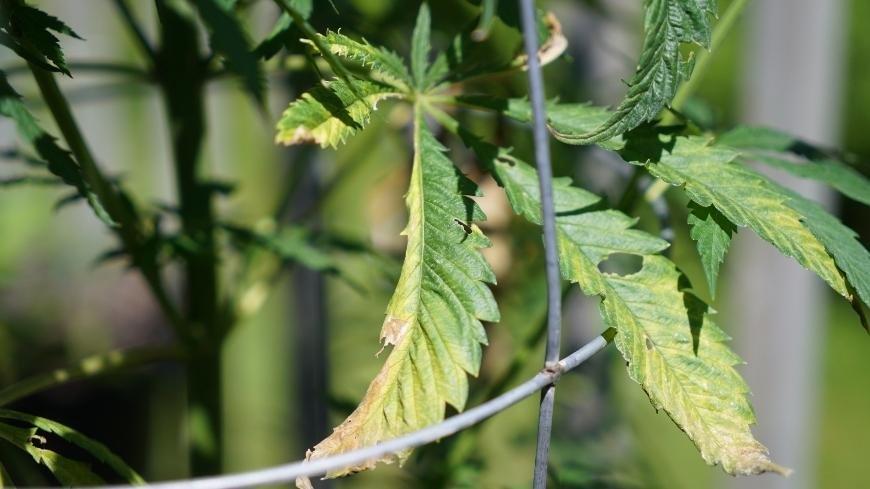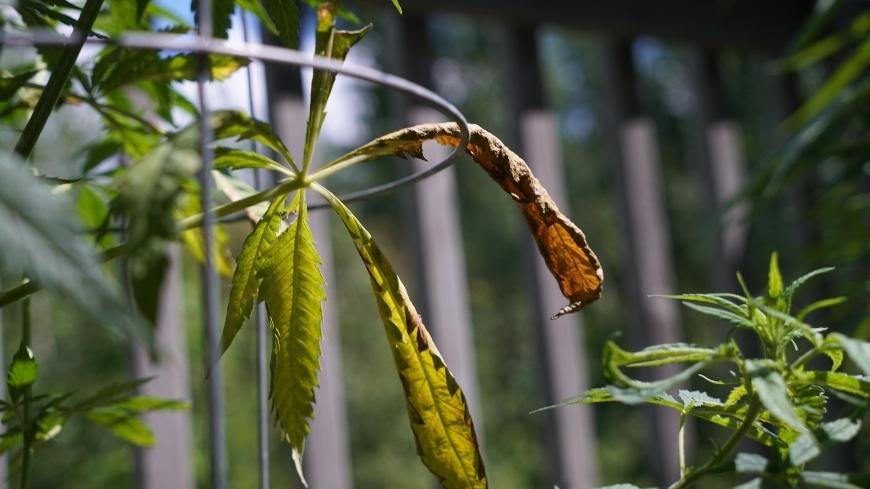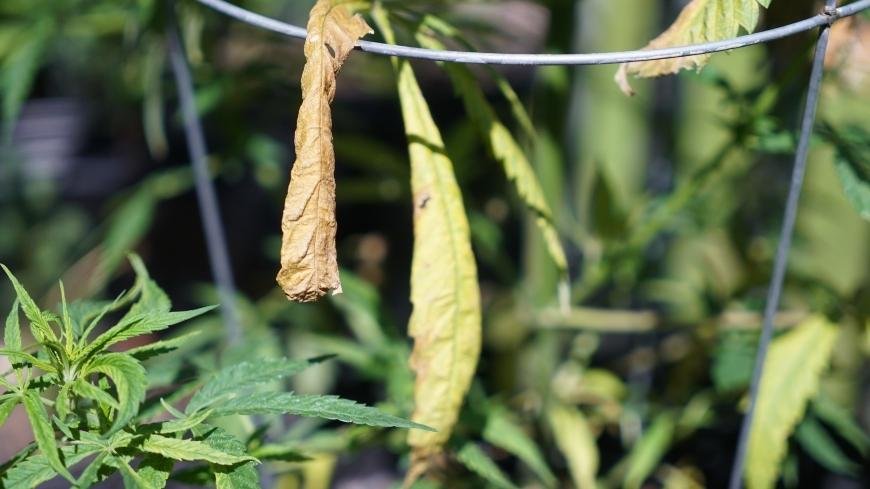How to Fix Potassium Deficiency in Cannabis Plants
Discover how to fix potassium deficiency in cannabis plants with our guide on identification, causes, pH balance, and effective solutions for growth.

When it comes to growing healthy and potent cannabis plants, understanding how to fix potassium deficiency is essential. Potassium is a fundamental nutrient for cannabis plants, as it contributes to the functioning of photosynthesis, water regulation and general plant growth. In this blog post, we will delve into the specifics of recognizing and resolving potassium deficiencies in cannabis plants.
Firstly, we will explore the telltale signs that indicate a cannabis potassium deficiency and discuss its potential causes. Next, maintaining proper pH balance within your growing medium will be highlighted as an essential step towards ensuring optimal nutrient absorption by your plants.
Furthermore, you'll learn about preventing overfertilization issues which can lead to nutrient lockout or burn while using potassium-rich fertilizers specifically designed for cannabis cultivation. Additionally, incorporating organic matter into your soil mix can significantly improve its ability to retain vital nutrients like potassium. Lastly, we'll touch upon using supplements such as potassium sulfate to effectively treat existing deficiencies in your marijuana plants.
Table of Contents:
- Identifying Potassium Deficiency in Cannabis Plants
- Symptoms of Potassium Deficiency
- Causes of Potassium Deficiency
- Maintaining Proper pH Balance
- Avoiding Overfertilization
- Using Potassium-Rich Fertilizers
- Adding Organic Matter to Soil
- Using Supplements such as Potassium Sulfate
- Frequently Asked Questions How to Fix Potassium Deficiency in Cannabis Plants
- Conclusion
Identifying Potassium Deficiency in Cannabis Plants
Identifying potassium deficiency in cannabis plants is key for any grower to ensure healthy growth and yields, so it's essential to be able to recognize the signs of this common issue. This common issue can significantly impact plant growth and yields if left unaddressed. In this section, we'll discuss the symptoms of potassium deficiency so that you can spot it early on and take action before it becomes a major problem.
Symptoms of Potassium Deficiency
- Yellowing Older Leaves: One of the first signs of potassium deficiency is yellowing older leaves at the bottom or middle part of the plant. As potassium levels decrease, these leaves will start turning pale green or yellow around their edges while maintaining green veins.
- Brown Spots: Another symptom is brown spots appearing on affected leaves. These necrotic areas may begin as small specks but can eventually merge into larger patches if not addressed promptly.
- Weak Stems: A lack of sufficient potassium also leads to weak stems that are more prone to breaking under stress from heavy buds or strong winds.
- Poor Bud Development: Lastly, plants suffering from potassium deficiency often exhibit poor bud development with smaller flowers and reduced overall yields compared to healthy plants.
Differentiating Between Nutrient Issues
Note that some symptoms associated with low-potassium levels might resemble those caused by other nutrient imbalances such as nitrogen or magnesium deficiencies. To accurately diagnose the issue, it's crucial to consider other factors like soil pH and overall plant health. For instance, nitrogen deficiency typically affects the entire plant rather than just older leaves, while magnesium deficiency often results in interveinal chlorosis (yellowing between leaf veins).
Recognizing a potassium insufficiency is crucial to guaranteeing flourishing growth of cannabis plants, as the mineral is an indispensable part of their nutrition. Moving on from identifying the issue, understanding the causes of potassium deficiency can help prevent further issues down the line.

Causes of Potassium Deficiency
Potassium deficiency in cannabis plants can be caused by various factors, which may hinder their growth and affect the overall yield. Understanding these causes is essential for taking appropriate preventive measures and ensuring healthy plant development. Some common reasons behind potassium deficiency include:
- pH Imbalances: An improper pH level in your growing medium can make it difficult for your cannabis plants to absorb nutrients, including potassium. Soil-grown cannabis should be maintained at a pH level between 6.0 and 7.0, while hydroponic systems should aim for 5.5 to 6.5 pH range for optimal nutrient absorption, including potassium.
- Overfertilization: Excessive use of fertilizers can lead to nutrient lockout, where an abundance of one nutrient prevents the absorption of others like potassium. It's crucial to follow the recommended dosage on fertilizer labels or seek guidance from experienced growers.
- Poor Soil Quality: Low-quality soils may lack sufficient amounts of potassium or other essential nutrients required for optimal plant growth. Opting for high-quality soil mixes specifically designed for cannabis cultivation will help ensure that your plants receive all necessary nutrients.
- Inadequate Watering Practices: Insufficient watering or overwatering can also contribute to potassium deficiency as both practices disrupt proper nutrient uptake by roots. Make sure you water your plants consistently, allowing them enough time between watering sessions so they don't become waterlogged.
To prevent these issues from affecting your cannabis crop, it's important to monitor conditions closely throughout the entire growing process. Regularly testing soil pH levels, keeping track of fertilization schedules, choosing quality materials, and implementing proper watering techniques are key steps in preventing potassium deficiency.
Maintaining Proper pH Balance
Understanding the importance of maintaining a proper pH balance for healthy plant growth and yields is crucial when growing cannabis plants. The pH balance refers to the acidity or alkalinity level in your soil, which directly affects nutrient availability for your plants. Potassium deficiency can often be caused by an improper pH level, as it becomes less available to the plant at certain levels.
The Ideal pH Range for Cannabis Plants
Cannabis plants prefer slightly acidic soil, with a pH range of 6.0 to 7.0 for soil-based environments and 5.5 to 6.5 when grown hydroponically. When growing in hydroponic systems, aim for a slightly lower range of 5.5 to 6.5 due to differences in nutrient uptake compared to soil-based environments.
How To Test Soil's pH Level
- pH Testing Strips: These are affordable and easy-to-use strips that change color when dipped into a sample of your soil mixed with water or runoff from your pots.
- Digital pH Meter: A more accurate option than testing strips, digital meters provide instant readings on their display after being inserted into the soil or liquid samples.
- Laboratory Soil Test: For professional growers seeking detailed information about their soils' composition, sending samples off to laboratories will provide comprehensive results including micronutrient levels and recommendations on amendments needed.
Tips To Maintain Optimal Soil pH Levels
- Avoid Overwatering: To prevent fluctuations in the soil's acidity levels, avoid overwatering your plants. This can cause nutrient lockout and make it difficult for the plant to absorb potassium.
- Use pH Adjusters: If you find that your soil's pH is too high or low, use a pH adjuster specifically designed for cannabis cultivation. These products are available in both liquid and powder forms, allowing you to raise or lower the pH as needed.
- Monitor Regularly: Consistently test your soil's pH levels throughout the growing process to ensure optimal conditions for potassium uptake by your cannabis plants.
Maintaining proper pH balance plays a vital role in preventing potassium deficiency in cannabis plants. By regularly monitoring and adjusting the acidity levels of your growing medium, you'll create an environment where nutrients like potassium are readily available for absorption by your plants, leading to healthier growth and higher yields.
Avoiding Overfertilization
One of the common causes of potassium deficiency in cannabis plants is overfertilization. When you provide your plants with excessive nutrients, it can lead to an imbalance and prevent them from absorbing potassium properly. Avoiding overfertilization is essential for providing cannabis plants with the right amount of nutrients and avoiding potassium deficiency.
Recognize Signs of Overfertilization
The first step in avoiding overfertilization is recognizing its signs. Some symptoms include:
- Burnt leaf tips or edges
- Yellowing leaves despite adequate nutrient supply
- Drooping or wilting plant even when watered correctly
- Poor root development leading to weak stems and branches
If you observe any of these indications, it's time to analyze your fertilizing techniques again.
Maintain a Feeding Schedule Based on Plant Needs
To avoid overfeeding your cannabis plants, establish a feeding schedule that takes into account their specific needs during different stages of growth. For example, young seedlings require less fertilizer than mature flowering plants. Make sure you're using appropriate nutrient ratios for each stage.
Monitor Nutrient Levels Regularly
Routinely check the nutrient levels in your growing medium (soil or hydroponic solution) by testing pH levels and monitoring electrical conductivity (EC). This will help you determine if there are any nutrient imbalances and make adjustments accordingly. For more information on how to test pH and EC levels.
Flush Your Growing Medium Periodically
Flushing your growing medium helps remove excess nutrients that may have built up over time. This can prevent nutrient lockout, which occurs when high concentrations of certain nutrients inhibit the absorption of others like potassium. To flush your growing medium, simply water it thoroughly with clean water (preferably distilled or reverse osmosis) until all excess nutrients are washed away.
By being attentive to the needs of your plants, you can prevent nutrient lockout and make sure they get sufficient potassium for flourishing growth by executing these steps.
Overfertilizing cannabis can be detrimental, causing nutrient deficiencies and other issues; therefore, using a fertilizer with potassium is important to ensure the plant gets the right amount. To ensure your plant gets the right amount of potassium, using a fertilizer that contains this essential element is key.

Using Potassium-Rich Fertilizers
If you've identified potassium deficiency in your cannabis plants, one of the most effective ways to address this issue is by using potassium-rich fertilizers. Various fertilizers, formulated to furnish the required amount of potassium for flourishing vegetation, are available. There are various types of potassium-rich fertilizers available on the market, each with its own unique benefits.
Soluble Potash (K2O)
Soluble potash (K2O), also known as water-soluble potassium, is a highly concentrated form of potassium that can be easily absorbed by cannabis plants. For soil and hydroponic gardening, this water-soluble potassium is a great choice. When choosing a soluble potash fertilizer, look for products with high K2O percentages to ensure maximum effectiveness.
Potassium Nitrate (KNO3)
Potassium nitrate (KNO3) fertilizer provides not only essential potassium but also nitrogen - another vital nutrient required by cannabis plants. The dual-action formula helps promote strong root development and overall plant health while addressing any existing deficiencies. Be sure to follow the manufacturer's instructions carefully when applying this type of fertilizer.
Tips for Using Potassium-Rich Fertilizers:
- Maintain proper pH levels: As mentioned earlier, pH imbalances can lead to nutrient deficiencies. Ensure that your growing medium's pH is within the optimal range for cannabis plants (6.0-7.0) before applying any potassium-rich fertilizers.
- Start with a lower dosage: When introducing new fertilizers to your cannabis plants, it's always best to start with a lower dosage and gradually increase it as needed. This helps prevent overfertilization and potential damage to your plants.
- Monitor plant response: Keep an eye on how your cannabis plants respond after applying potassium-rich fertilizer. If you notice positive changes in growth and overall health, continue using the fertilizer according to the recommended schedule; if not, consider adjusting the application rate or trying a different product.
Incorporating potassium-rich fertilizers into your cannabis plant care routine can make all the difference when dealing with potassium deficiency issues. By providing adequate levels of this essential nutrient, you'll be well on your way towards healthier, more productive cannabis plants.
Adding Organic Matter to Soil
If you're looking to boost potassium levels in your cannabis plants, adding organic matter to the soil is an excellent way to do so. Organic matter not only provides essential nutrients like potassium but also improves soil structure and water retention, which can help your plants thrive. In this section, we'll explore some of the best sources of organic matter for increasing potassium levels in your cannabis plants.
Compost
Compost is a fantastic source of organic matter that's rich in potassium and other essential nutrients. Compost can be created from a range of items, such as kitchen waste, foliage, grass cuttings and more. By incorporating compost into your soil mix or top-dressing around existing plants, you'll be providing them with a slow-release source of potassium that will benefit their growth throughout the season.
Banana Peels
Surprisingly, banana peels are rich in potassium, making them an ideal source of slow-release nutrients for your cannabis plants. Instead of tossing those peels away after enjoying a banana snack, consider chopping them up and burying them near the base of your cannabis plant roots. As they decompose over time, they release valuable nutrients - including much-needed potassium - directly into the surrounding soil.
Kelp Meal
Kelp meal is another organic option for increasing potassium levels in your cannabis plants. Derived from dried seaweed, kelp meal contains not only potassium but also other essential nutrients and trace elements that promote healthy plant growth. To use kelp meal, simply mix it into the soil before planting or top-dress around existing plants.
Wood Ash
If you have access to untreated wood ash (from a fireplace or fire pit), this can be an excellent source of potassium for your cannabis plants. However, it's important to note that wood ash raises the pH level of soil, so it should be used sparingly and only if your soil pH needs adjusting. Sprinkle a bit of the wood ash near your plants and delicately mix it into the top layer of soil.
Using Supplements such as Potassium Sulfate
If your cannabis plants are displaying signs of potassium deficiency, a supplement like potassium sulfate can be used to provide the necessary nutrients. Potassium sulfate is a water-soluble fertilizer containing essential nutrients for healthy plant growth, such as potassium and sulfur.
Benefits of Using Potassium Sulfate
- Promotes strong root development: Adequate potassium levels help in developing a robust root system, allowing the plants to absorb more nutrients and water efficiently.
- Increase resistance to diseases and pests: Proper potassium nutrition strengthens cell walls, making it harder for pathogens and pests to invade the plant tissue.
- Better flower production: Healthy amounts of potassium encourage abundant flowering, leading to higher yields in cannabis plants.
- Faster recovery from stress: A well-nourished plant with sufficient potassium will recover faster from environmental stresses such as drought or temperature fluctuations.
Frequently Asked Questions How to Fix Potassium Deficiency in Cannabis Plants
What is the solution for potassium deficiency in cannabis?
The solution for potassium deficiency in cannabis plants involves maintaining proper pH balance, using potassium-rich fertilizers, adding organic matter to the soil, and applying supplements like potassium sulfate. Regularly monitoring your plants' health and adjusting their nutrient intake can help prevent deficiencies.
How can potassium deficiency be corrected in plants?
To correct potassium deficiency in plants, start by checking and adjusting the pH level of your growing medium. Then, apply a high-potassium fertilizer or supplement such as potassium sulfate. You may also add organic matter like compost or aged manure to improve soil quality and nutrient availability.
What is the best source of potassium for cannabis plants?
The best sources of potassium for cannabis plants include specially formulated potash fertilizers, which contain high levels of soluble potash (K2O), as well as natural sources like wood ash, kelp meal, greensand, and composted fruit waste. These materials provide essential nutrients that promote healthy growth and flowering.
What are the first signs of potassium deficiency in cannabis?
The first signs of potassium deficiency in cannabis include yellowing leaves with brown edges or tips along older foliage. As it progresses, you may notice curling leaf edges (necrosis) followed by overall plant weakness with reduced resistance to diseases and pests. Early detection allows for quicker intervention and recovery.
Conclusion
Overall, it is important to identify and treat potassium deficiency in cannabis plants as soon as possible to ensure healthy growth and high-quality yields. Striving for the correct pH level, abstaining from over-fertilization, employing potassium-enriched fertilizers, including organic components to soil and deploying supplements such as potassium sulfate are all viable tactics to resolve this predicament.



























































































































